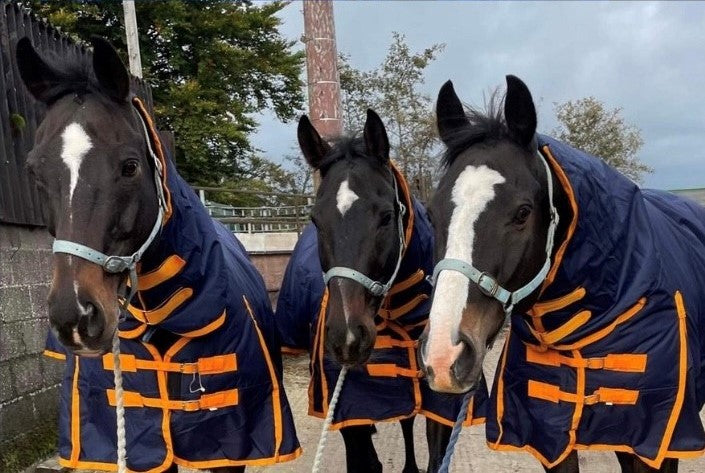Benefits of rugging your horse

At this time of year, I’m sure the main conversation on your yard is which rug are you putting on your horse today? I know it is at mine.
Generally, a rug keeps the horse’s warm during cold weather and cool during warm weather. Rugs have various uses, they protect their entire body, including the neck, while you can get others which cover their main flank. There are brightly coloured or reflective rugs to help owners find or identify their horses, especially during dark winter months. The right rug choice will help to regulate your horse’s body temperature and maintain a healthy condition. Rugging is very different for every horse as it depends on breed, weight, climate, their workload, and even their coats themselves.
For basic protection if they are turned out in the field, natural elements such as rain, snow, and cold windy weather. This is where a waterproof turnout rug is recommended, the temperature outside and as explained above your horses needs must be taken into consideration to decipher the weight of the rug needed. If you stable your horse and don't have access to much turn out, a stable rug may be needed for inside to give them extra warmth. During winter, horses need more feed to produce the body heat that’s necessary for them to stay warm. Putting a rug on your horse can help save on extra feed expenses during the colder months.
A rug can also protect the horse’s coat and keep it clean and dry as much as possible. When horses are turned out in fields, they may not have access to trees or built-in field shelters to keep dry. Cold or rainy months can also cause bacterial infections and diseases such as rain scald. To give them protection, a rug is a good option. Also, if your horse is ridden a rug will of course keep them clean and dry for convenience of tacking up as we can’t tack up a dirty wet horse!
Horses grow their coat faster and thicker ready for winter. Their coats grow faster depending on the day’s length. Since days are shorter before winter, a horse grows their coat faster. This way, they can keep their bodies naturally warm when it comes round to winter. If you prefer to maintain a short coat for your horses, a horse rug can help with that by using a very light rug earlier in the year to maintain a shorter coat.
Your finer breeds of horses such as a Thoroughbred or Arab have a naturally thinner coat and may need the extra warmth of a rug to not lose condition.
If you fully clip your horse, you need to compensate taking the coat off by using a rug to keep them warm. This is because they will then be unable to produce heat naturally, as when they are cold their hair stands on end creating a layer of heat and insulation.
Older or unwell horses often struggle to self-regulate their temperature. Older horses can also have an arthritic flare up in cold and damp temperatures which in turn restricts movement. This reduces the creation of body heat as they aren’t moving round as much as they would.
If you have an underweight horse, rugging can prevent weight loss by slowing down the thermoregulation process. The heat and energy saved becomes part of the horse’s fat reserves which in turn helps the horse to gain weight.
However, if you have an overweight horse over-rugging can also be a problem. This stops the horse being able to regulate their body temperature which can lead to weight gain, as remember food provides energy and generates heat which in turn warms the horse from the inside out. Eating is heating. Extra weight and food intake can increase the risk of laminitis, a disease that can be fatal.
Remember a rug that was appropriate in the morning, can lead to overheating by the afternoon particularly if the sun comes out temperatures can differ 10 degrees from morning until afternoon. When a horse overheats, blood is diverted to the skin surface to remove excess heat through sweating. This creates a warm and moist environment which is where bacteria and infections thrive, this can lead to skin diseases, it is very uncomfortable and distressing for the horse and owner.
To conclude, your decision to rug should always be assessed according to the horse’s individual needs as every horse like humans, are different. Healthy horses can naturally withstand cold temperatures if they have access to shelter with plenty of forage. Always make sure your horse has a well-fitted rug to stop infections and rug rubs. Horses which have been clipped or are unable to regulate their body temperature such as underweight, ill, or older horses will benefit from wearing a rug. Make sure to be careful not to over rug to prevent your horse from overheating in the Autumn and spring months.
References from Everything Horse Magazine.
